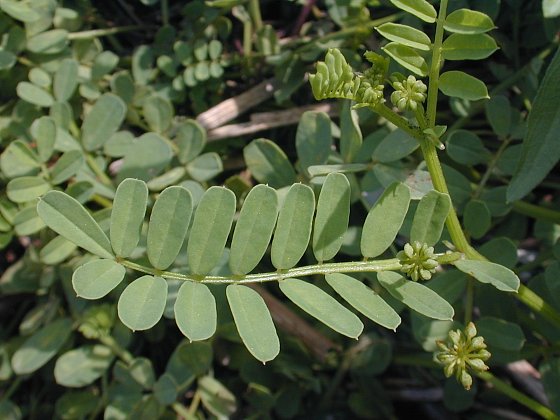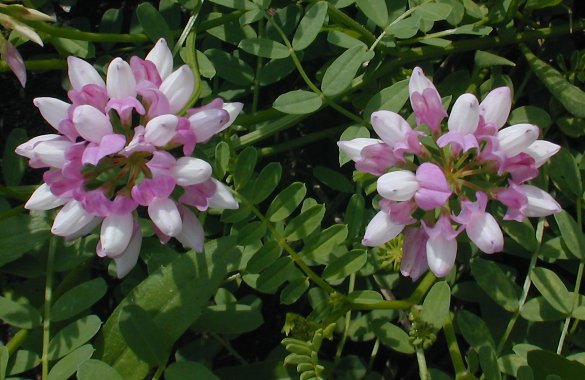Description: This herbaceous perennial plant is about 1-3' tall, branching occasionally. The hairless stems are more or less ascending, often relying on adjacent vegetation for support. Because the stems are produced in abundance from rhizomes, Crown Vetch often forms a dense layer of leafy vegetation that excludes other plants. The alternate compound leaves are about 6" long when fully mature; they are odd-pinnate with 11-25 leaflets. Each leaflet is about ¾" long, ¼" across, oblong, hairless, and smooth along the margins. Each compound leaf is more or less sessile because its first pair of leaflets occurs near the stem. Tendrils are not produced. From the axils of the upper compound leaves, there develops individual flowering stalks up to 6" in length. At the apex of each stalk, there is an umbel of 10-25 flowers.

Each flower is
about ½" long, consisting of 5 pink or white petals and a green calyx
with 5 pointed lobes. The flower of Crown Vetch has a typical pea-like
appearance, with an upright standard and a lower keel. The standard is
often a brighter shade of pink than the rest of the flower. The slender
pedicel of each flower is about ¼" long. The blooming period occurs
from late spring until late summer, peaking during early and mid-summer
for about 2 months. Each fertile flower produces an angular seedpod
about ½–2" long. This seedpod consists of 1-7 segments; it is
constricted between these segments and terminates in a long pointed
beak. Each seed is oblong and slightly reniform. The root system
produces abundant spreading rhizomes. This plant often forms vegetative
colonies, and it occasionally reseeds itself.
Cultivation:
The preference is partial or full sun, moist to mesic conditions, and
fertile loamy soil. Drier conditions and poor soil are tolerated,
although vegetative growth will be less robust. Crown Vetch appears to
have few problems with disease and insect pests. Its adds nitrogen to
the soil by forming root nodules in association with rhizobial
bacteria. Crown Vetch is an aggressive plant that can be difficult to
get rid of.

Range &
Habitat:
The non-native Crown Vetch is a common plant that has been observed in
nearly all
areas of Illinois, except the NW area of the state (see Distribution
Map). Official records undoubtedly underestimate the
distribution of this plant. Habitats include moist to mesic black soil
prairies, weedy meadows, banks of rivers and drainage ditches,
embankments of roadsides and highway overpasses, flower gardens, and
miscellaneous waste places. Crown Vetch was introduced into the United
States from Europe by various transportation departments for erosion
control and highway beautification. It is still planted as an
ornamental plant in flower gardens, even though it invades natural
areas readily.
Faunal Associations:
The flowers are cross-pollinated by long-tongued
bees, including honeybees. According to Müller (1873/1883), nectar is
exuded
from the surface of the fleshy calyx on the outside of the flower. Some
insects are known to feed on the foliage of Crown Vetch in North
America.
These species include both adults and larvae of the Bean Leaf Beetle (Cerotoma trifurcata),
both adults and larvae of a flea beetle (Disonycha punctigera),
larvae of a leaf-miner fly (Liriomyza
trifoliearum), larvae of the butterflies, Orange
Sulfur (Colias eurytheme)
and Melissa Blue (Lycaenides
melissa melissa), larvae of the skipper, Wild Indigo
Duskywing (Erynnis
baptisiae), the Alfalfa Plant Bug (Adelphocoris limbatus),
Marmorated Brown Stink Bug (Holcostethus
limbolarius), Differential Grasshopper (Melanoplus differentialis),
and Red-legged Grasshopper (Melanoplus
femurrubrum); see Clark et al. (2004), Spencer &
Steyskal (1986), Gucker (2009), Bouseman et al. (2006), Wheeler et al.
(1983), and Rider (2009) for more information. The foliage of Crown
Vetch contains the toxic cardiac alkaloid, coronillin. As a result, it
is potentially toxic to some mammals, including horses and humans.
However, such ruminant mammals as elk, deer, and most classes of
livestock appear to be immune to this toxin and they consume the
foliage readily. Because Crown Vetch forms dense colonies of plants, it
provides good protective cover for ground-nesting birds, meadow voles,
and rabbits (Gucker, 2009).

Photographic
Location:
A weedy meadow at Judge Webber Park in Urbana, Illinois.
Comments:
Crown Vetch (Securigera
varia) is another introduced plant from abroad that has
run amok
in the countryside. It is an attractive plant with distinctive umbels
of pink flowers. Other members of the Bean family usually produce
racemes of flowers, or they have flowerheads consisting of tiny tubular
flowers (e.g., clovers). Another introduced species that is quite
common, Lotus corniculata (Birdsfoot Trefoil),
produces similar umbels of flowers. However, these flowers are bright
yellow or yellow-orange and its leaves are trifoliate. A
scientific synonym of Crown Vetch is Coronilla
varia.